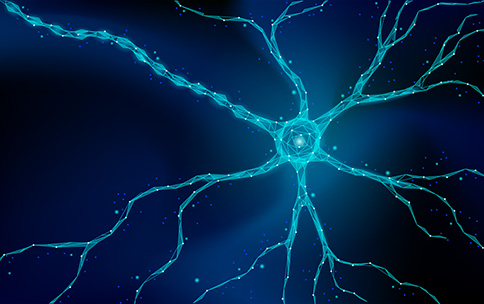
The vagus nerve runs from the brain through the lower abdomen and controls many bodily functions including hiccups, digestion, heart rate, and breathing. Therapies that stimulate nerves with electrodes within the body hold promise for the treatment of many diseases, and vagus nerve stimulation (VNS) is already approved to treat epilepsy and depression. VNS may be able to help treat migraine, heart diseases, inflammatory bowel disease, stroke, rheumatoid arthritis, and many other conditions. However, it has been difficult to translate VNS technology into treatments for patients. Humans and other animals have differences in nerve anatomy, so electrodes and stimulation patterns that show results in non-human models often don’t translate well for humans in clinical trials. Furthermore, there is person-to-person variation in the structure of vagus nerves that causes differences in responses to nerve stimulation and can also cause undesired side effects. Researchers in the Common Fund’s Stimulating Peripheral Activity to Relieve Conditions (SPARC) program are working towards developing a map of the human vagus nerve. With this map, scientists will create digital models that can be used to simulate the effects of different nerve anatomies, types of electrodes, and stimulation intensities and patterns. Being able to test the effects of stimulation in a completely customizable way will allow researchers to tailor nerve stimulation approaches that reduce side effects and have more therapeutic success across many patients.
SPARC-funded research led by Drs. Warren Grill and Nicole Pelot developed a tool called Automated Simulations to Characterize Electrical Nerve Thresholds (ASCENT). ASCENT is an open-source, digital platform to model stimulation of nerves using 3D models that can be tailored to use custom nerve anatomies. Users of this tool first import a model of the nerve they want to test, which can be a generic nerve or a sample-specific image. Then, they add the geometry and specifications of the electrode they want to simulate, and ASCENT calculates the electrical stimulation from the electrode and how it would affect the nerve within individual nerve fibers. The tool reports the threshold stimulation amount required to activate the nerve fibers, which can inform clinical use of electrodes and help understand side effects caused by different types of nerve fibers activating at different stimulation levels. A video walkthrough of the steps of ASCENT can be found here.
The researchers tested ASCENT with digitized models of real samples from human, pig, and rat vagus nerves found in the neck, along with corresponding data on nerve stimulation thresholds from real-world experiments. For all three species, their simulations of vagus nerve stimulation were accurate to the experimental data, even capturing differences between individuals’ responses to stimulation. They were also able to predict that common side effects such as throat pain and coughing from stimulation in this neck region are likely due to leakage of the electrical current away from the vagus nerve, suggesting the need for electrodes designed to reduce this leakage. ASCENT’s ability to accurately model the responses of all types of nerve fibers will continue to be refined, and its ability to calculate nerve stimulation parameters will help accelerate the development of new VNS therapies while reducing unwanted side effects.
Read more
- Validated computational models predict vagus nerve stimulation thresholds in preclinical animals and humans. Musselman ED, Pelot NA, Grill WM. J Neural Eng. 2023 Jun 15;20(3). doi: 10.1088/1741-2552/acda64.


